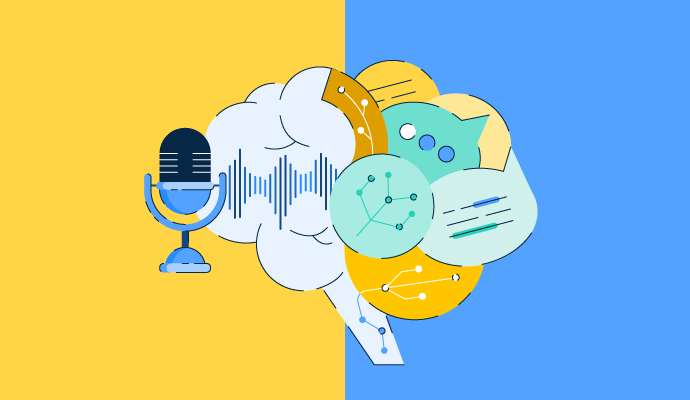June 26, 2024
 by Alyssa Towns / June 26, 2024
by Alyssa Towns / June 26, 2024

Natural language processing (NLP) and large language models (LLM) have become indispensable tools in shaping how we communicate, work, and interact with technology.
Owing to such innovation, recognizing the difference between the two is more important now than ever!
Take, for instance, utilizing an artificial intelligence (AI) program to generate or create text: Are you using NLP or LLMs? You’re actually using LLM software because these systems can comprehend, interpret, and generate human-like text to accomplish a broad spectrum of natural language tasks.
Understanding the difference between these two technologies is important to utilizing their strengths, managing limitations, and selecting the right tool for your use case. Let’s dive right into NLP vs. LLM and explore their unique applications.
NLP is a broad field in AI that helps machines understand, process, and generate human language. Comparatively, LLMs, a subset of NLP, utilize large-scale neural networks and massive datasets to perform advanced tasks such as text generation and contextual understanding.
Natural language processing is a form of AI technology in which computer programs interpret text and spoken words to perceive, analyze, and understand human language. NLP algorithms and modeling study context, structure, and the meaning of words and sentences to comprehend language. It can help produce summaries, translate languages, perform sentiment analysis, and answer questions (based on the information it has) to the best of its ability.
Common NLP tasks include:
As society’s usage of AI technologies increases, so do businesses' NLP use cases. Natural language processing offers productivity and efficiency benefits for organizations and individuals alike to streamline workflows, enhance customer service, and gain valuable insights from large volumes of text data. Below are some of the common NLP use cases today.
Apple’s Siri and Amazon’s Alexa assistants use voice recognition to understand user inquiries and questions, providing useful results and information in response. Many people rely on these technologies to answer daily life questions (e.g., What’s today’s weather?), conduct quick online searches, and add items to to-do and shopping lists.
Spam filters in email applications use NLP techniques to detect potential spam emails by identifying words or phrases that may indicate a spammy message. Upon detection, the email is classified as spam and shuffled to the spam folder to avoid clogging your inbox.
Today, service providers like Google offer additional forms of email categorization that use NLP techniques. For example, Gmail uses a machine learning algorithm based on signals (who an email comes from, the content of the email, and similar content comparisons) to determine which category an email belongs: primary, social, promotions, updates, or forums.
If you’ve ever used an autocorrect or autocomplete feature, such as when texting on an iPhone or other smartphone device, you’ve experienced the power of NLP. These high-value features are a savior to business professionals and individuals alike.
Autocorrect uses algorithms to identify misspellings and suggest corrections based on dictionary words. Autocomplete functionality predicts a possible next-best word based on the surrounding context of a sentence.
Source: 9to5Mac
Traveling to another country can feel scary if you don’t speak the language of your destination. Fortunately, NLP makes applications like Google Translate readily available to help people communicate despite native language barriers and disconnects.
Source: Google Translate
Large language models (LLMs) are advanced AI computer programs that can understand and generate human-like language. They are trained on massive amounts of text data from across the Internet, including websites, news articles, blog posts, and social media content. By analyzing this data, LLM identifies patterns in constructing words and sentences to attempt to understand how they work together semantically.
Post-training, LLMs can complete a wide range of NLP tasks, such as summarizing text, performing sentiment analysis, and creating content based on available information. Moreover, they can be refined and customized for specific tasks or outputs through techniques such as:
GPT4, Gemini, Meta Llama 3, and Claude 3 are just a few of the LLMs available. LLMs help businesses and individuals with knowledge transfers, content generation, ideation, and performance improvements. Below are some of the most common applications of LLMs.
LLMs can assist with various content creation tasks, including generating outlines for written content or meetings, character development for storyline planning, lesson plan and study guide generation for teachers, brainstorming travel locations and itineraries, and social media content ideas, to name a few. These tools are helpful for kickstarting the ideation process and providing individuals with a starting point that they can further enhance with their own unique information, insights, and voice.
For example, I used Gemini to brainstorm beach vacation destinations within five hours of my hometown:
Source: Gemini
LLMs can help developers generate code using contextual understanding capabilities to interpret the desired outcome of the input. They can utilize predefined templates, conditional statements, or loops in the prompt input to complete their task. Additionally, LLMs may be able to help address potential bugs and syntactic errors based on best practices and coding standards learned during their training.
LLMs help analyze customer reviews to determine the overall sentiment toward a product or service. Instead of having humans read and analyze individual reviews, businesses collect customer feedback and reviews from review sites, social media, and other online locations and input them into a pre-trained or fine-tuned model for processing.
The LLM then analyzes and assigns a sentiment score based on the patterns identified in the text. This helps organizations leverage LLMs as part of their social media monitoring strategy to gauge public perception of the brand.
Chatbots are beneficial for various brands and industries. In particular, many eCommerce stores use these chatbots to answer questions quickly, prevent delays, and encourage purchasing. Chatbots are useful for performing narrow tasks, such as responding to commonly asked questions, accessing order details, or quickly scheduling appointments or meetings.
UrbanStems, a fresh flower delivery company, has a chatbot that can help with order tracking, late delivery, quality complaints, and questions related to order senders.
Source: UrbanStems
Both NLP and LLMs play a central role in human language technologies. Both are powered by vast generative AI infrastructure that supports large-scale training and deployment. While they are related, there are several key differences in how they work and when to apply them. Here are five key differences to keep in mind.
NLP encompasses specific tasks, whereas LLMs are more general-purpose in their abilities. In other words, NLP broadly describes specific tasks that enable computers to interpret and generate human language, such as part-of-speech tagging, named-entity recognition, and word sense disambiguation. Given its specific nature, NLP generally involves developing models tailored to specific areas of expertise or industries.
On the other hand, LLMs can perform a wide range of general language-related tasks. LLMs are trained on vast amounts of text data and can be applied to tasks like text generation, answering questions, summarizing information, and enabling chatbots with information to have human-like conversations.
NLP uses data processing techniques like tokenization, stop word removal, stemming, lemmatization, and feature extraction. Training datasets are often specific in NLP and are generally smaller than those used for training LLMs.
LLMs, on the other hand, use a type of deep learning known as a transformer to understand content through relationships in information. Through unsupervised learning, LLMs are trained on extensive information across books, articles, websites, and more, allowing the models to learn language patterns without specific guidance.
While LLMs are related to NLP, the use cases differ due to their distinct capabilities, training methods, and available information. NLPs are good at extracting information, identifying and classifying entities, analyzing parts of speech for syntax analysis, conducting language translations, and converting speech to text.
LLMs are more generalized and assist users with content creation, chatbot conversations, generating automatic summaries and meeting notes, retrieving information based on large datasets, and conducting deep sentiment analysis across user reviews and feedback.
Due to their broader scope, LLMs are better suited for more complex applications, whereas NLP use cases are narrow and task-specific.
A single LLM can be a versatile tool with minimal fine-tuning for tasks like writing assistance, answering customer questions, and summarizing lengthy reports and documents. In other words, you can use a LLM for various needs, making them highly versatile.
NLPs can be tailored to and trained for specific tasks, making them less versatile but more customized (potentially effective and efficient) for one task, like analyzing sentiment-labeled data.
Accuracy and F1 score are metrics that measure machine learning model performance. Accuracy measures the model's correct predictions across a dataset (hence, how accurate the model is) by dividing the number of correctly predicted positive and negative events by the total number of events. The F1 score is the harmonic mean of a model's precision and recall. It’s an arithmetic calculation representing the model’s overall performance in a balanced measurement.
Bilingual Evaluation Understudy (BLEU) and Recall-Oriented Understudy for Gisting Evaluation (ROUGE) scores best suited machine translation and text summarization tasks, respectively. BLEU measures the overlap between machine-generated and reference text, while a ROUGE score evaluates an automatically produced summary against the references provided. Both BLEU and ROUGE scores range between zero and one.
The Accuracy, F1 score, BLEU, and ROUGE scores are applicable across NLP and LLMs, but their roles vary. In traditional NLP, Accuracy, and F1 scores are applied to narrow text classification tasks with a clearly defined scope. Similarly, BLEU and ROUGE scores help measure summarization in NLP tasks.
In the context of LLMs, the Accuracy and F1 scores can be used similarly but across a broader range of tasks. BLEU and ROUGE scores are often combined with other metrics and human evaluations when evaluating LLMs to assess the model’s capabilities and output quality at length.
Here's a video that summarizes the basics of NLP vs. LLM.
Source: Dscout
With its diverse range of techniques, natural language processing provides specialized solutions for tasks like voice recognition, text prediction, and language translation. In comparison, large language models are revolutionizing content creation, code generation, sentiment analysis research, and conversational AI chatbot capabilities. The choice between NLP and LLMs depends on the scope, training data, use cases, and versatility needed to achieve your objectives.
End your large language model software search here with our list of 10 best LLMs for 2025!
Alyssa Towns works in communications and change management and is a freelance writer for G2. She mainly writes SaaS, productivity, and career-adjacent content. In her spare time, Alyssa is either enjoying a new restaurant with her husband, playing with her Bengal cats Yeti and Yowie, adventuring outdoors, or reading a book from her TBR list.
Large language models (LLMs) understand and generate human-like text. They learn from vast...
 by Sagar Joshi
by Sagar Joshi
Zero-shot learning gives (artificial) intelligence a shot to learn concepts minus a lot of...
 by Alyssa Towns
by Alyssa Towns
Causal language models (CLMs) are the backbone of real-world AI systems driving...
 by Sudipto Paul
by Sudipto Paul
Large language models (LLMs) understand and generate human-like text. They learn from vast...
 by Sagar Joshi
by Sagar Joshi
Causal language models (CLMs) are the backbone of real-world AI systems driving...
 by Sudipto Paul
by Sudipto Paul


